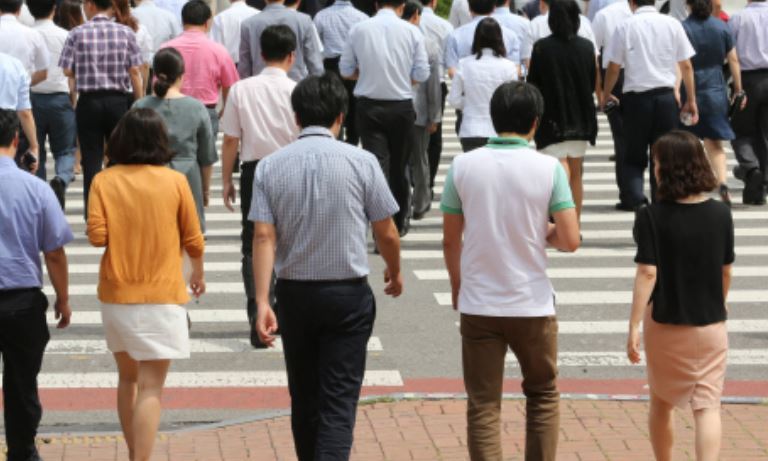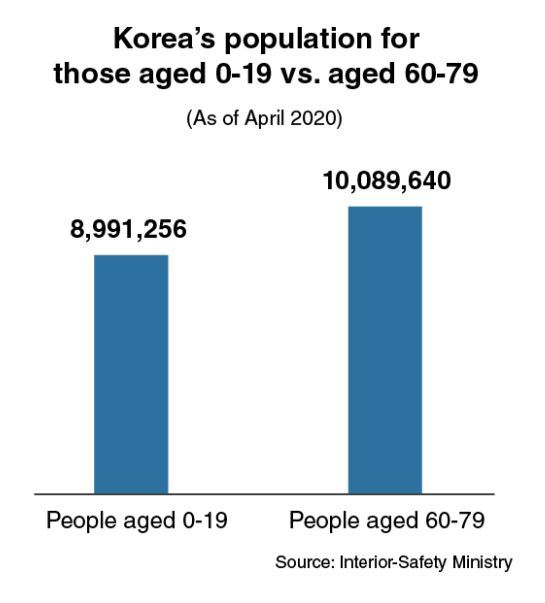[News Focus] Working age population post 12-year low in portion
In Korea, people under 20 fewer than those in 60-70s by 1 million
By Kim Yon-sePublished : May 10, 2020 - 17:05

SEJONG -- South Korea’s working age population -- people aged between 15 and 64 -- posted 37.2 million as of April with the monthly figure declining both on-year and on-month basis.
According to the Ministry of Interior and Safety, share of the population considered working age stood at 71.8 percent last month, compared to 72.3 percent a year earlier.
Further, this marked the lowest at least in 12 years since the government officially started compiling the data in January 2008. The figure for 12 years earlier (72.4 percent) was even higher than last month’s 71.8 percent.
The working age population, which peaked at 73.4 percent in January 2012, has continued to slide over the past eight years (particularly for recent four years) -- 73.2 percent in April 2016, 72.9 percent in April 2017, 72.6 percent in April 2018 and 72.3 percent in April 2019.
Most of the baby boomer generation in Korea, born between 1955 and 1963, still belongs to the working age population.
But as those born in 1955 are have started to reach 65 this year, they are exiting the working age range. The working age population is therefore expected to shrink faster in the coming years.
Statistics Korea forecasts that the proportion of the population aged 15-64 will fall below 70 percent of the population within four years to 69.9 percent in 2024, while some observers predict the pace could speed up.
The agency also estimates that this figure would be less than 60 percent in 2036 and less than 50 percent in 2056.
By 2065 the senior population is projected to overtake the working-age population, relative to the total population, in 2065, when working-age people will comprise 45.9 percent of the total and seniors 46.1 percent, according to the estimate from Statistics Korea.

The number of children under 10 years of age was just 4.1 million in April -- putting this age group at the bottom of the rankings among age groups under 70.
People in their 50s topped the list with 8.66 million, followed by those in their 40s with 8.36 million, those in their 30 with 6.99 million and those in their 20s with 6.8 million.
Those aged 60-69 outnumbered people aged 10-19 by 6.45 million to 4.88 million.
The number of Koreans aged 70-79 reached an all-time high of 3.63 million. Those in their 80s and 90s, as well as centenarians, also posted record numbers -- 1.67 million, 241,192 and 20,913.
For a wider comparison, the number of people aged 0-19 (8.99 million) was fewer by more than 1 million than people aged 60-79 (10.08 million) as of last month.
Korea recorded a fertility rate of 1.654 in 1993, when the government started compiling official statistics. That level, though relatively low, was still enough to ensure a sustainable working-age population. Korea’s fertility rate is estimated to have surpassed 2 in the early 1980s and 4 in the early 1970s, according to unofficial statistics.
But the fertility rate continued to decline in the 1990s and 2000s and posted 1.187 in 2013. The figure for 2018 was 0.977, below the 1 mark for the first time in history, and hit 0.92 in 2019, according to Statistics Korea.
A demographic researcher said a large portion of people in their 20s and 30s are avoiding marriage or childbirth “in the wake of their frustration with a tough job market and high apartment prices (in Seoul and Gyeonggi Province in particular).”
The data held by the Organization for Economic Cooperation and Development shows that Korea has recorded the steepest gradient in terms of decline in the proportion of youth population aged 14 or younger
A research fellow at LG Economic Research Institute predicted that the shrinking workforce could slash gross domestic product growth by 0.4 percentage point between 2020 and 2024, and by 0.5 percentage point between 2025 and 2029.
By Kim Yon-se (kys@heraldcorp.com)





![[From the Scene] Monks, Buddhists hail return of remains of Buddhas](http://res.heraldm.com/phpwas/restmb_idxmake.php?idx=644&simg=/content/image/2024/04/19/20240419050617_0.jpg&u=20240419175937)








![[From the Scene] Monks, Buddhists hail return of remains of Buddhas](http://res.heraldm.com/phpwas/restmb_idxmake.php?idx=652&simg=/content/image/2024/04/19/20240419050617_0.jpg&u=20240419175937)

![[KH Explains] Hyundai's full hybrid edge to pay off amid slow transition to pure EVs](http://res.heraldm.com/phpwas/restmb_idxmake.php?idx=652&simg=/content/image/2024/04/18/20240418050645_0.jpg&u=20240419100350)

![[Today’s K-pop] Illit drops debut single remix](http://res.heraldm.com/phpwas/restmb_idxmake.php?idx=642&simg=/content/image/2024/04/19/20240419050612_0.jpg&u=)